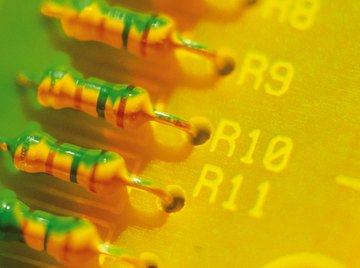
An electrical circuit contains elements such as resistors, capacitors, inductors and voltage sources. They can be wired in series or parallel, and they always provide a return path for the current within a closed loop. In order to lower the amperage of an electrical circuit, you must either lower the circuit's voltage or increase its resistance. Lowering amperage is done by applying Ohm's law, given by the formula I = V/R, where I is the circuit's total current in amperes, V is the voltage and R is the resistance.
Add resistors to the circuit to increase the total resistance. A higher resistance results in a lower amperage. The resistance of a resistor is measured in ohms. A resistor works by "resisting" the flow of current through the circuit. Be careful that you don't exceed the manufacturer-listed wattage rating of a resistor.
Lower the circuit's amperage by adding a variable resistance device or increasing the resistance on any you already have in the circuit. Variable resistance devices include transistors, FETs and rheostats, which are two-terminal variable resistors.
Reduce the voltage in your circuit to lower the amperage. For example, lower the voltage source from a 12V battery to a 9V battery.
References
About the Author
Sean Mann has been a freelance writer since 2010. With thorough knowledge and experience in technological fields such as computer software, hardware, the internet and programming, he creates online content for various websites. Mann has a Bachelor of Science in computer science from Ohio State University.
Photo Credits
Comstock/Comstock/Getty Images
